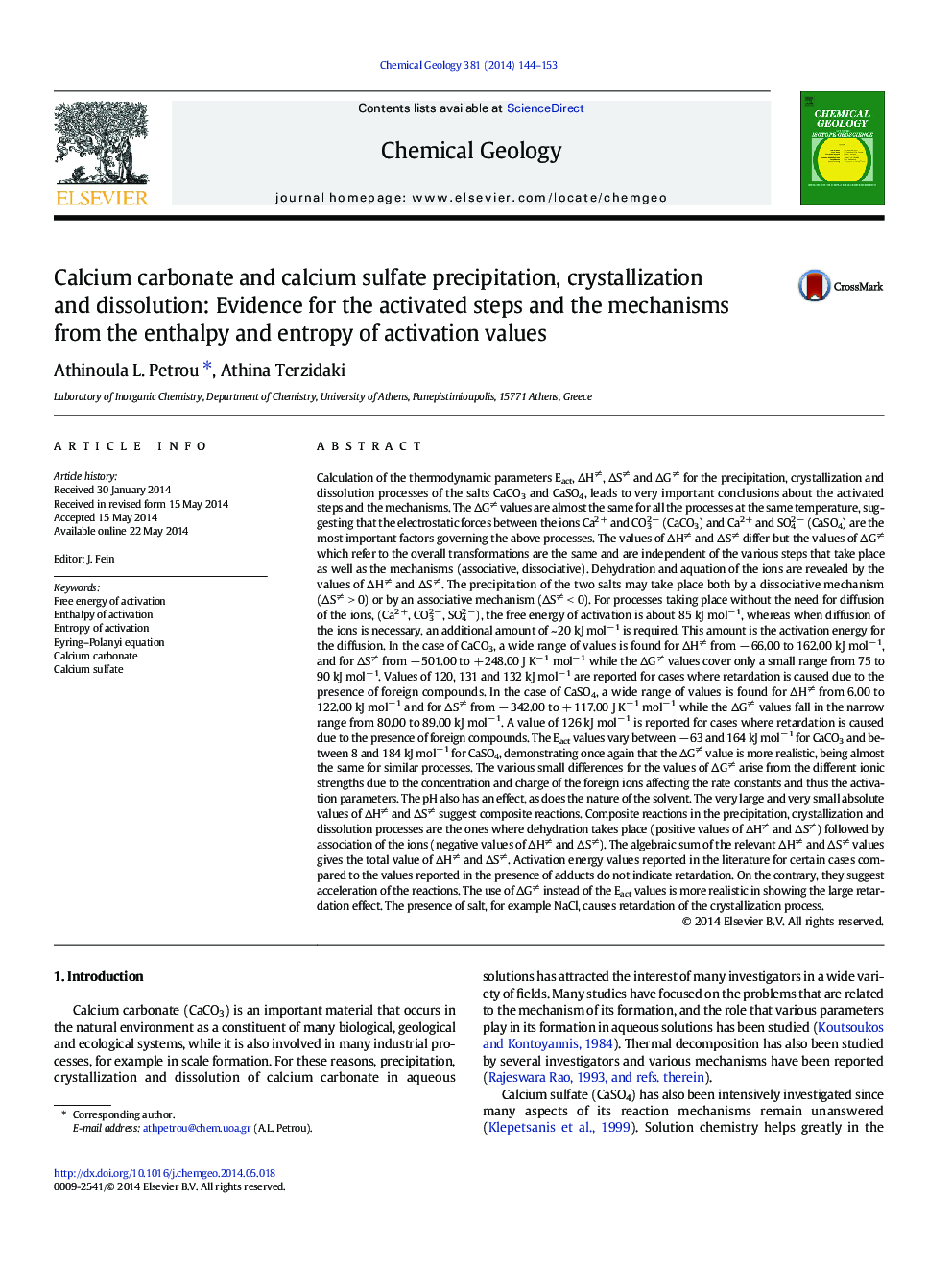| کد مقاله | کد نشریه | سال انتشار | مقاله انگلیسی | نسخه تمام متن |
|---|---|---|---|---|
| 6436610 | 1637591 | 2014 | 10 صفحه PDF | دانلود رایگان |
- Activation parameters for processes involving calcium carbonate are presented.
- Activation parameters for processes involving calcium sulfate are presented.
- The free energy of activation is about 80 kJ molâ 1 for precipitation, crystallization and dissolution.
- The presence of foreign ions causes retardation of the processes.
- Diffusion of the ions adds about 20 kJ molâ 1 in the free energy of activation.
Calculation of the thermodynamic parameters Eact, ÎHâ , ÎSâ and ÎGâ for the precipitation, crystallization and dissolution processes of the salts CaCO3 and CaSO4, leads to very important conclusions about the activated steps and the mechanisms. The ÎGâ values are almost the same for all the processes at the same temperature, suggesting that the electrostatic forces between the ions Ca2 + and CO32 â (CaCO3) and Ca2 + and SO42 â (CaSO4) are the most important factors governing the above processes. The values of ÎHâ and ÎSâ differ but the values of ÎGâ which refer to the overall transformations are the same and are independent of the various steps that take place as well as the mechanisms (associative, dissociative). Dehydration and aquation of the ions are revealed by the values of ÎHâ and ÎSâ . The precipitation of the two salts may take place both by a dissociative mechanism (ÎSâ  > 0) or by an associative mechanism (ÎSâ  < 0). For processes taking place without the need for diffusion of the ions, (Ca2 +, CO32 â, SO42 â), the free energy of activation is about 85 kJ molâ 1, whereas when diffusion of the ions is necessary, an additional amount of ~ 20 kJ molâ 1 is required. This amount is the activation energy for the diffusion. In the case of CaCO3, a wide range of values is found for ÎHâ from â 66.00 to 162.00 kJ molâ 1, and for ÎSâ from â 501.00 to + 248.00 J Kâ 1 molâ 1 while the ÎGâ values cover only a small range from 75 to 90 kJ molâ 1. Values of 120, 131 and 132 kJ molâ 1 are reported for cases where retardation is caused due to the presence of foreign compounds. In the case of CaSO4, a wide range of values is found for ÎHâ from 6.00 to 122.00 kJ molâ 1 and for ÎSâ from â 342.00 to + 117.00 J Kâ 1 molâ 1 while the ÎGâ values fall in the narrow range from 80.00 to 89.00 kJ molâ 1. A value of 126 kJ molâ 1 is reported for cases where retardation is caused due to the presence of foreign compounds. The Eact values vary between â 63 and 164 kJ molâ 1 for CaCO3 and between 8 and 184 kJ molâ 1 for CaSO4, demonstrating once again that the ÎGâ value is more realistic, being almost the same for similar processes. The various small differences for the values of ÎGâ arise from the different ionic strengths due to the concentration and charge of the foreign ions affecting the rate constants and thus the activation parameters. The pH also has an effect, as does the nature of the solvent. The very large and very small absolute values of ÎHâ and ÎSâ suggest composite reactions. Composite reactions in the precipitation, crystallization and dissolution processes are the ones where dehydration takes place (positive values of ÎHâ and ÎSâ ) followed by association of the ions (negative values of ÎHâ and ÎSâ ). The algebraic sum of the relevant ÎHâ and ÎSâ values gives the total value of ÎHâ and ÎSâ . Activation energy values reported in the literature for certain cases compared to the values reported in the presence of adducts do not indicate retardation. On the contrary, they suggest acceleration of the reactions. The use of ÎGâ instead of the Eact values is more realistic in showing the large retardation effect. The presence of salt, for example NaCl, causes retardation of the crystallization process.
Journal: Chemical Geology - Volume 381, 14 August 2014, Pages 144-153
